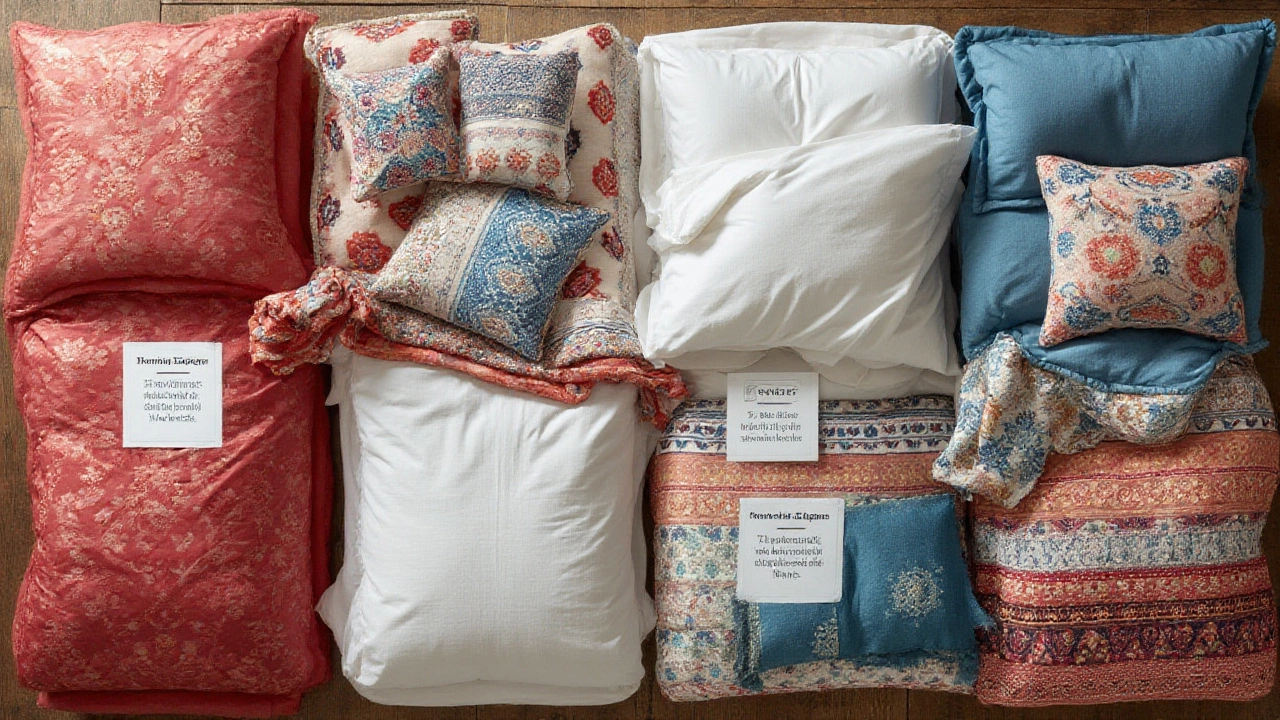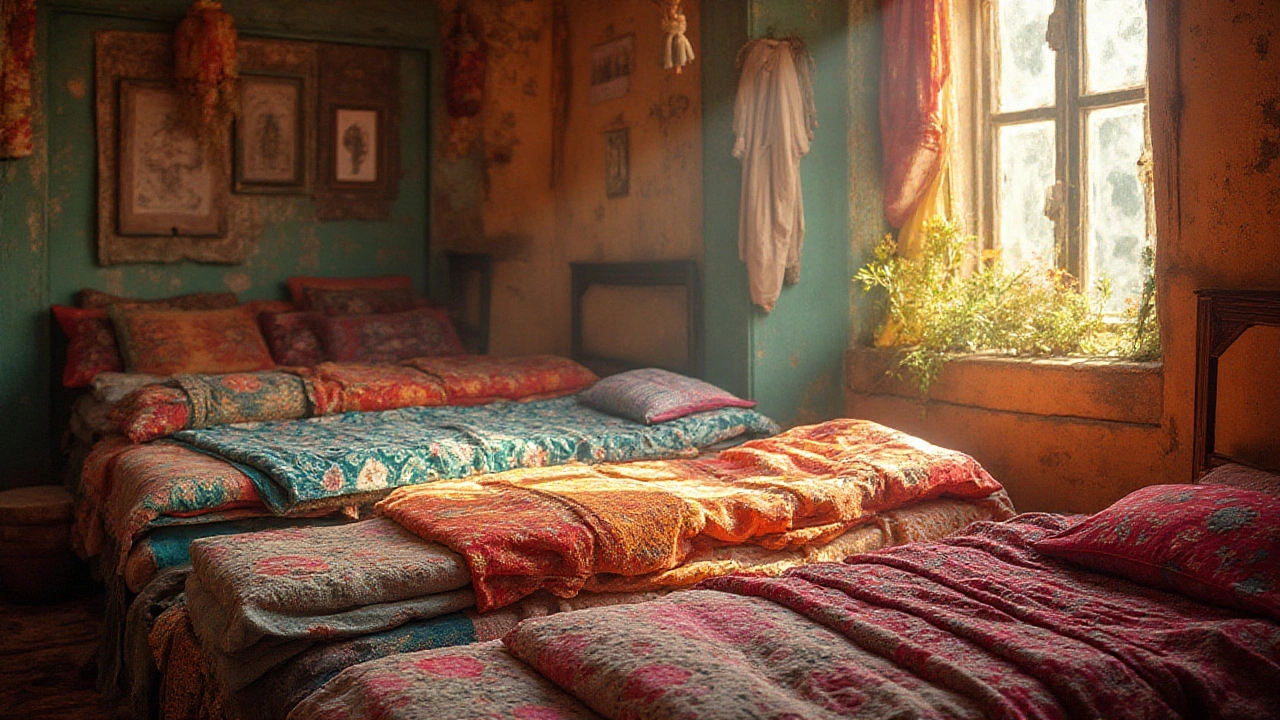When you picture a cozy bed, what pops into your head first? Is it the crisp, cool touch of a fresh sheet, or the soft fluff of a down comforter? For something so simple, bedding has a surprisingly rich vocabulary—and loads of people get confused about which words mean what. It’s not just sheets and blankets we’re talking about. There’s a whole world of synonyms, each with slightly different spin depending on where you are and what you’re shopping for. If you’ve ever gone hunting for new bedding and been drowned in words like “linens,” “bedclothes,” or “bed linen,” you’re definitely not alone.
The Many Words for Bedding
Let’s cut through the confusion right away—bedding can go by plenty of different names, but they all boil down to the stuff we use to make our beds comfy, clean, and inviting. In the UK, where I live, “bedding” and “bed linen” get tossed around a lot. In the US, you’ll hear “linens” or sometimes “bedclothes.” Fancy a bit of history? The term “linens” comes from the Latin word for flax, since sheets used to be made from linen fabric before cotton took over the market.
Here’s a quick run-down of synonyms and what they actually mean, so you won’t get tripped up next time you’re browsing a shop or scrolling online:
- Bedding: The all-encompassing term. It refers to everything that goes on a bed, from sheets to covers to pillowcases.
- Bed linen: Common in the UK. Means sheets, pillowcases, and sometimes duvet covers.
- Linens: The traditional term, often used more generally for household fabrics, but with a slight lean toward bed-related items.
- Bedclothes: An old-school word, especially in the US and Ireland, covers everything used to dress the bed for sleeping.
- Sheets: Usually refers to the flat sheet (top sheet) and fitted sheet (bottom sheet).
- Blankets, comforters, duvets, throws: These technically fall under bedding, but they’re often specified on their own due to their different purposes.
- Coverlets, quilts, bedspreads: All serve to cover your bed and add warmth or style, sometimes layered atop other bedding.
Of course, that’s not the whole list. Some designers and bedding brands use even fancier terms—think “ensemble” or “sleep set,” just to sound posh!
What’s Actually Included in Bedding?
So what does “bedding” really mean when you see it on a label or hear someone say it? The answer matters a lot if you’re shopping for a set or moving into a new flat. In a typical package, you’ll get sheets (both fitted and flat), pillowcases, and maybe a duvet cover. Sometimes, terms like “bed sets” throw in extras like pillow shams or a decorative throw.
Here’s a table breaking down what’s usually included in a standard bedding set, just for clarity:
| Item | Also Called | Standard Inclusion? |
|---|---|---|
| Fitted Sheet | Bottom Sheet | Always |
| Flat Sheet | Top Sheet | Usually |
| Pillowcase | Pillow Slip | Always (x2 for doubles) |
| Duvet Cover | Comforter Cover | Often |
| Pillow Sham | Decorative Pillowcase | Sometimes |
| Bed Skirt | Valance | Rarely |
If you’re in the UK, don’t expect a top sheet automatically. It’s way more common to use just a fitted sheet and a duvet cover, especially in student rooms or flatshares. Across the Atlantic, Americans often swear by the top sheet, which divides opinion every few months on Twitter. My cat Milly loves to tunnel under the top sheet, so I’m firmly pro–top sheet in this household.

Special Bedding Terms Around the World
Travel a bit and you’ll soon discover: not every country has the same bedtime lingo. In Australia and New Zealand, “manchester” is the word for what Brits and Americans call bedding. The origin? Nothing to do with the city’s football club—Manchester, England, was once the world’s hotspot for textile production, so Aussies borrowed the city name. Kind of like how we ask for a Kleenex instead of a tissue.
In Scandinavian countries, you’ll run into words like “sengetøj” (Danish) or “sängkläder” (Swedish), directly translating to “bed clothes.” Japanese bedding gets even more specific with “futon” meaning a traditional mattress and “shikibuton” for the sleeping mat. Double-checking these terms can save you a headache (and possibly a few pounds) if you’re buying bedding as a gift for a friend abroad.
In some cultures, bedding can even signal family status or wealth. During Victorian times, owning fine linens was a sign of prosperity. While nobody’s peeking at your thread count these days (except maybe your posher aunt), the word “linens” still has a bit of poshness attached to it—and brands know it.
Which Bedding Synonym Should You Use?
When you’re chatting with friends or shopping online, the best word to use really depends on what you want and where you are. But here’s a trick: if you’re after everything that covers your mattress and pillows, say “bedding.” Shopping for just sheets and pillowcases? Go with “bed linen” or “linens.” If you’re putting together a posh guest room, you might reach for “bedclothes” (it sounds almost old-fashioned and cozy, straight out of a Jane Austen novel). If in doubt, check the packaging or product description. Brands sometimes sneak in decorative pieces and bump the price—so it’s handy to know what each word covers.
Don’t be afraid to ask a shop assistant for clarification. This can save you from ending up with just pillowcases when you expected a full set. And if you’re ordering online, scan the reviews. Real people will always tell you if something’s missing or if the listing’s misleading.

Tips and Fun Facts for Bedding Enthusiasts
Ready for some tips to find, use, and talk about bedding like a pro?
- Thread count isn’t everything. Feel the fabric if you can. Sometimes a lower thread count but higher quality cotton will beat a cheap, ultra-high thread count set any day.
- Don’t get hooked by terminology. “Linens” don’t have to be made of linen, and “cotton” can cover a range from budget to luxurious. Always check the actual fibre content label!
- If you want hotel crispness at home, iron your pillowcases and top sheet. Most hotels use pressed cotton. Or do what I do: make your bed as soon as you finish drying the sheets, and let the mattress pull out most of the wrinkles naturally.
- For allergy sufferers, try “hypoallergenic bedding” or look for terms like “anti-dust mite.”
- Properly washing bedding keeps it fresh, but avoid using too much detergent, which can build up over time. Go easy—your nose and your skin will thank you.
Bedding stores often use seasonal marketing tricks, so you’ll find “flannel bedding” or “percale sets” promoted just as the weather changes. Percale feels cool and crisp (perfect for hot sleepers), while flannel’s for snuggling in a cold British winter. Change up your bedding vocabulary to match your needs: “throw” for quick warmth on the sofa, “blanket” for layers, “duvet” for instant coziness.
Weirdly, the word “sheet” often pops up in metaphors—think “clean sheet” or “three sheets to the wind.” No, neither has much to do with actual beds, but it just shows how deeply bed stuff is woven into language.
